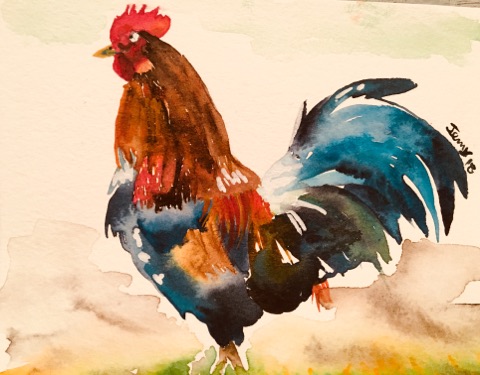Lezione di acquerello – Parte 2 / Lesson of watercolor - Part 2 (ITA/ENG)

)
Hello everyone! I'm back here with a new watercolor lesson. I am very happy that the previous one liked it^^.
Today I would like to talk about the types of watercolors you can find on the market, the advantages and disadvantages (for me).
Watercolor in plate or solid.
It is watercolor dried and placed in long strips and then cut into dry cakes called "godet" or "means godet" depending on the size. Being solid they are more practical for use on the road or outdoors (they are small small boxes).
Pasta watercolor.
Sold in squeezing tubes, not to be confused with tempera or acrylics.
Liquid watercolor.
Recently introduced on the market, they can be used pure or diluted and can be used with an airplane.
Watercolor in stick.
This article is also very recent, looks like a stick similar to charcoal, but it is also dried watercolor.
Given this information on the various types of watercolors on the market, I am teaching you, but also personally what I think of these products and how to best use them.
I always use watercolors in paste (in tube) and lately I also approached those in stick to make games ^^
At the level of pigments they are much brighter and being pasty you can get to do an almost materic watercolor work.
The platelets (godet) are comfortable to carry around or at school but for me they do not have a pigmented yield, they can be good for making glazes or bases.
The watercolor sticks are small toys ^^ they can be used to give intensity to a sign or make a part material; if grated on a sheet wet with beautiful effects of drops (try to believe).
Finally the watercolors in drops.
Try it once just because I'm not much to my liking or better not necessary for the work I do. But I can suggest you do it yourself (if you're not sure if you can buy them).
Take an empty dropper, pour a pinch of watercolor in paste and water, mix and then you can paint directly with the dropper to give dripped effects or stains.
My work "il gallo" has been realized with watercolors in paste and watercolors in sticks, wet on dry the subject and wet on the background, dimensions: 13x18, paper 100% cotton.
In conclusion, to begin to approach the watercolor I suggest the "Godets" and tubes in dough (the primary colors and a black will be fine), brand Winsor and Newton.
Artists in the history of art who used the watercolor: Vasilij Kandinskij, Giovanni Canaletto
Also for today the lesson ends here, next time I will talk about how to make lights and white (much requested!)
See you soon!
)
Ciao a tutti! Eccomi di nuovo qui con una nuova lezione di acquerello. Sono molto contenta che la precedente sia piaciuta ^^. Oggi vorrei parlarvi delle tipologie di acquarelli che potete trovare in commercio, dei vantaggi e degli svantaggi (per me).
Acquarello in piastrina o solido.
Si tratta di acquerello asciugato e sistemato in lunghe strisce e quindi tagliato in panetti secchi detti “godet” o “mezzi godet” a seconda delle dimensioni. Essendo solidi sono più pratici per l'uso in viaggio o all'aperto (sono piccole scatoline di piccole dimensioni).
Acquarello in pasta.
Venduto in tubetti da spremere, da non confondere con le tempere o gli acrilici.
Acquarello liquido.
Di recente introduzione sul mercato, possono essere usati puri o diluiti e si prestano all'uso con aeropenna.
Acquarello in stick.
Anche questo articolo è molto recente, si presenta come un bastoncino simile al carboncino, ma anch’esso è acquarello essiccato.
Date queste informazioni sulle varie tipologie di acquarello presenti sul mercato vi illustro didatticamente ma anche personalmente cosa penso di questi prodotti e come utilizzarli al meglio.
Io uso sempre gli acquarelli in in pasta (in tubetto) e ultimamente mi sono avvicinata anche a quelli in stick per fare giochini^^.
A livello di pigmenti sono molto più luminosi ed essendo pastosi si può arrivare a fare un lavoro ad acquerello quasi materico.
Le piastrine (godet) sono comode da portarsi in giro o a scuola ma per me non hanno una resa pigmentosa, possono andare bene per fare velature o basi.
Gli stick di acquarello sono dei piccoli giochini^^ si possono usare per dare intensità ad un segno o rendere materica una parte; se grattugiato su un foglio bagnato da effetti bellissimi di gocce (provare per credere).
Infine gli acquarelli liquidi.
Provati una volta sola perché non sono molto di mio gradimento o meglio non necessari per i lavori che faccio io. Posso suggerirvi però di farveli da se (se non siete sicuri di acquistarli).
Prendete un contagocce vuoto, versateci un puntina di acquerello in pasta e acqua, mescolate e dopo di che potrete dipingere direttamente col contagocce per dare effetti sgocciolati o macchie.
Il mio lavoro “il gallo” è stato realizzato con acquarelli in pasta e acquerelli in stick, bagnato su asciutto il soggetto e bagnato su bagnato lo sfondo, dimensioni: 13x18, carta 100% cotone.
In conclusione, per iniziare ad approcciarsi all’acquarello io suggerisco i “Godet” e tubetti in pasta (i colori primari e un nero andranno benissimo), marca Winsor e Newton.
Artisti nella storia dell’arte che hanno utilizzato l’acquerello: Vasilij Kandinskij, Giovanni Canaletto
Anche per oggi la lezione finisce qui, la prossima volta vi parlerò come fare luci e bianchi (tanto richiesti!)
A presto!

Brava, ottima spiegazione e bella realizzazione :-)
Grazie Miti
oh mio dio, questa è una bellissima maneggevolezza ad acquerello
Grazieee